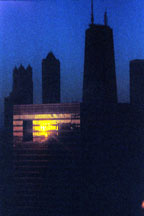| |
Which brings us to Lakeshore
East . . .
Lakeshore East, the massive 26-acre site east of Columbus between Wacker
and Randolph, is being developed by none other than Magellan, in partnership
with James Loewenberg's real estate company, Near North Properties. The
$2.5 billion project, which could include as many as 17 new mid-rise and
high-rise buildings as well as a park, town homes, and an elementary school,
will be one of the largest ever to be managed by a single company in Chicago's
history.
In Lakeshore East, Magellan is creating a new neighborhood from scratch.
They could give us another sterile set of boxes like Illinois Center,
which would be disappointing. They could give us an entire district of
the types of towers they've been building, which would be tragic. Or they
could stop phoning it in and step up to their responsibility as caretakers
of Chicago's architectural heritage.
It's in Magellan's interest--and Chicago's--not to blow it. The condo
boom of the last few years, with building after building selling out before
a shovel of earth had been turned, is history. As early as July of last
year, reports showed at least 5,000 unsold condo units in the city center,
and there's nothing to indicate things will get better anytime soon. What's
it going to take, then, to move the 5,000-some units Magellan envisions
for Lakeshore East?
Now is the time for a first-principles rethinking of what a mixed-use
development of this order should be. The initial signs are encouraging.
Magellan brought in Skidmore Owings & Merrill to revamp the overall
site plan, which wound up winning an award from the American Institute
of Architects. Now they've released a rendering of the site's first building,
the Lancaster, whose design could presage a break from the developer's
usual bargain-bin approach. There's a generous use of glass and a more
varied facade, and a steel trellis caps the roof. It's definitely not
an embarrassment--but why not aim higher? Why not, within a set of design
guidelines for the site as a whole, go after the city's best talent for
future buildings--Tigerman or Jahn, Lagrange or Johnson, Bistry or Woodhouse?
How about Carol Ross
Barney--and not just for the school, where the city of Chicago will
make the call? How about tapping a great architect who's never built in
Chicago? Or holding an international competition for a key building? If
it's handled right, the project could become the charge that restarts
Chicago's architectural heartbeat.
But when we aren't the ones approving the zoning, or providing the financing,
or snapping up ugly condominiums as if they were gold coins lying in the
street--how can we do anything about it?
When Montgomery Ward spent his social standing dry to save the lakefront
for public use, he held no elected office. When Herbert Greenwald hired
Mies to design 860-800 Lake Shore Drive, it wasn't on a mandate from a
public commission. When Cindy Pritzker brought Frank Gehry to Millennium
Park, it wasn't because she was getting a tax break. The only requirement
is to care. Act as befits your position; speak out as befits your ability.
This past summer the New York Times and its architectural critic, Herbert
Muschamp, unveiled a set of dazzling proposals for the redevelopment of
the World Trade Center site and its environs. The cream of New York architects--Richard
Meier, Peter Eisenman, Charles Gwathmey and others--came together to counter
the business-as-usual approach of the government agency charged with rebuilding
Ground Zero, expanding their group to include the likes of Koolhaas and
Vinoly and Vietnam Memorial architect Maya Lin. The results of their collective
labor can be found on the Web at www.nytimes.com/2002/09/08/magazine/08REBUILD.html.
The drawings and models represent a mind-boggling convergence of the best
of current architectural thought. You may respond strongly, and not always
approvingly, but you will be engaged.
No city department, no developer, asked these architects for their input.
In New York, as in Chicago, the standard MO for new buildings is to proffer
mediocrity and control the opposition. For the moment, however, September
11 seems to have awakened New Yorkers' deepest feelings about their city
in a way that has made this approach unacceptable.
Within a month the Lower Manhattan Development Corporation had dumped
its original uninspired proposals and designated seven design teams, including
many of the same architects who had worked on the New York Times project,
to come up with seven new real plans. The possibilities, presented in
December, are now up at www.renewnyc.org/plan_des_dev/wtc_site/new_design_plans.
Great buildings are monuments--repositories of memory--to the era in which
they rise. Our skyline is a library of the stories we tell about ourselves--what
we believe, what we would like others to believe about us, what we aspire
to, and ultimately, despite our best efforts to evade and conceal, what
we are. The story of far too many of Chicago's new buildings is one of
exhaustion, of routine without spirit. We have to live with it, but to
accept its influence over future building is to concede the death of Chicago
architecture. New Yorkers chose to fight the slow smothering of their
city's soul. If we love Chicago, can we do any less? 
 |
Page: |
|
|
|
|
|
lynnbecker@lynnbecker.com
© Copyright 2003-2004 Lynn
Becker All rights reserved.
|



